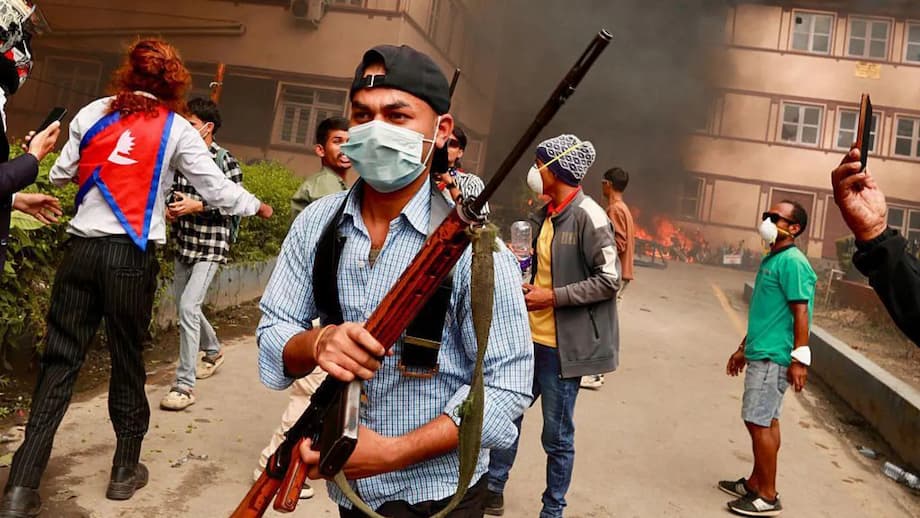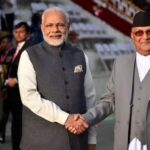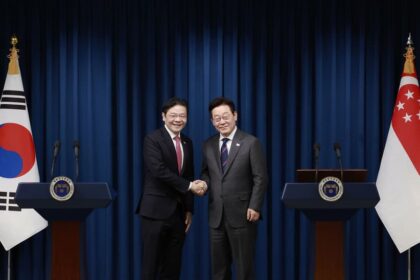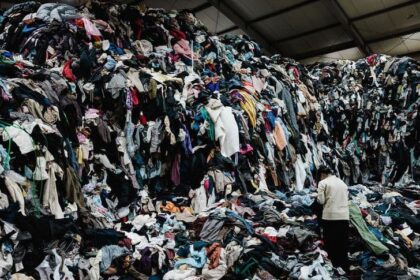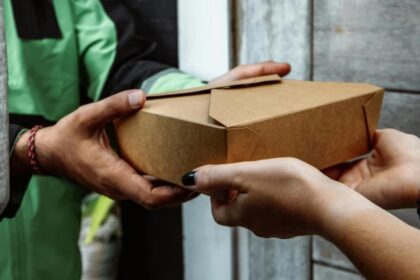A youth led uprising shakes Kathmandu
Smoke rose over Kathmandu as soldiers patrolled near shuttered shops and burned out offices, capping two days that transformed a youth driven anti corruption protest into Nepal’s worst unrest in decades. At least 30 people have died and more than 1,000 have been injured, according to health authorities and UN updates, after demonstrators stormed and torched parliament and other state institutions. Prime Minister KP Sharma Oli resigned, curfews took hold across major cities, and the army warned it would act to restore order if violence continued.
- A youth led uprising shakes Kathmandu
- How a social media ban turned anger into a mass movement
- A deadly confrontation around parliament
- Symbols of the state in flames
- A leader steps down, a vacuum opens
- Why Gen Z is at the center
- The army on the streets and calls for dialogue
- Regional stakes and diplomatic reactions
- What could come next for Nepal
- Key Points
Young Nepalis, many in their late teens and early twenties, say the movement began as a stand against corruption and a sweeping shutdown of social media platforms. They insist that peaceful marches were hijacked by outsiders bent on destruction. Security forces used tear gas, rubber bullets, water cannons, and, according to rights groups, live rounds. Crowds ransacked buildings and set fire to the homes of senior politicians, while the administrative heart of the capital, Singha Durbar, turned into a blackened shell. Inside parliament, protesters chanted and waved the national flag as flames took hold at the entrance.
Oli’s exit created a leadership vacuum, and streets that were chaotic on Monday and Tuesday fell into a jittery quiet under army checkpoints. With parliament damaged, police stations overrun, and several prisons breached, the state scrambled to regain control. Still, the same youth who had rallied against graft and censorship began sweeping glass from roads and returning looted firearms, small signs of a society trying to steady itself after a shocking rupture.
How a social media ban turned anger into a mass movement
The immediate trigger was a government order to block 26 social media platforms that had not registered with Nepal’s Ministry of Communication and Information Technology. The decision came after a Supreme Court directive that platforms operating in Nepal establish a formal presence so authorities could monitor unlawful content. Some services, like TikTok and Viber, complied. Others did not. The government then switched off access to Facebook, Instagram, WhatsApp, and other widely used platforms, breaking communication channels for families and businesses and drawing outrage from a generation that grew up online.
Officials argued the move was necessary to counter hate speech, scams, and disinformation. Young Nepalis heard something else, an attack on free speech and a heavy handed response to a buzzing online movement that had been exposing alleged privileges enjoyed by the children of senior politicians. The campaign, known locally through hashtags about nepo kids, circulated videos and photos of luxury holidays, designer goods, and perceived favoritism. The content struck a nerve in a country where many young people see few job prospects and depend on cheap data to connect with relatives working abroad.
The nepo kids campaign explained
The term borrows from pop culture’s nepo baby, but in Nepal it took on a sharper political edge. Posts accused children of prominent figures of flaunting wealth out of step with public service. Supporters say the online heat did not target private lives for sport, it challenged a culture of patronage and impunity. The government’s ban, lifted within a day after clashes turned deadly, came too late to slow the surge. Demonstrations already spanned the Kathmandu Valley and other cities, expanding from a single issue into a broader call for clean governance.
Platforms are integral to daily life for a large share of Nepalis. Digital researchers estimate more than 14 million social media identities in a country of roughly 30 million people at the start of 2025. Shutting those services touched every corner of society, from entrepreneurs who market on Instagram to migrant families who depend on Facebook and WhatsApp to talk across time zones. When lines of riot police met crowds outside parliament, anger that had been simmering for years boiled over.
A deadly confrontation around parliament
The bloodiest day was Monday. Thousands gathered near the legislature in New Baneshwar, many of them students still in uniform. When parts of the crowd pushed toward the restricted zone around parliament, police fired tear gas and rubber bullets, then real ammunition. At least 19 people died on the first day, most of them in Kathmandu, and hundreds were treated in hospitals for bullet wounds, head injuries, and tear gas exposure. Two deaths were recorded in Itahari on the eastern plains. The next day brought more clashes and more deaths, pushing the nationwide toll to at least 30.
Doctors at the National Trauma Center described chest and head wounds as they worked nonstop on those brought in from the streets. Witnesses recounted police firing into dense crowds and officers being chased away by protesters who threw stones and torched vehicles. As videos spread, public anger intensified, and by late Tuesday the prime minister’s position had become untenable.
From a hospital ward in central Kathmandu, a wounded college student described what he saw. His testimony, carried by international media, is one of many that point to chaos before the shooting began and to outside groups stirring violence near the front lines. He said a protester standing just ahead of him fell to a chest wound, and that friends hauled him to safety through smoke and sirens.
A young protester in the capital, Sareesha Shrestha, told reporters that the social media blackout felt like the final insult after years of job scarcity and patronage. Many of her peers spoke of poor prospects at home and foreign work as the default path. Remittance income makes up a large share of Nepal’s economy, and entire neighborhoods are knit together through conversations on phones. When police cracked down, they say, the stakes were no longer abstract.
Prime Minister Oli addressed the nation through a resignation letter after two days of turmoil. He framed his departure as a step to unlock a political answer within Nepal’s constitutional process. News outlets published excerpts that captured the tone of a leader forced to yield to a street movement he had dismissed only days earlier.
In his letter, the prime minister set out why he was stepping aside. He said he wanted space for a peaceful solution and a reset of national politics under the constitution.
In view of the adverse situation in the country, I have resigned effective today to facilitate the solution to the problem and to help resolve it politically in accordance with the constitution.
Many protesters reacted with a mix of jubilation and grief. They celebrated the end of a leader they blamed for a harsh crackdown, then lit candles for classmates they had lost. Security forces, after a period of intense clashes, kept more distance as the army took the lead on the streets under curfew orders.
On Tuesday night, the army chief urged restraint and called for an end to the unrest, while the United States and other partners appealed for calm and dialogue. The national human rights commission condemned excessive force and asked authorities to protect the right to peaceful protest. UN Secretary General António Guterres expressed sadness at the loss of life and called for investigations that meet human rights standards.
Symbols of the state in flames
Few images captured the shock like black smoke pouring from Nepal’s parliament building. Protesters smashed windows, spray painted slogans, and cheered around a fire at the main entrance. The Supreme Court building and multiple ministries in the Singha Durbar complex were also set ablaze or ransacked. In the aftermath, the court postponed hearings and entire wings of government offices stood charred. Media outlets, police stations, and schools were targeted in some neighborhoods, including a private school linked to a senior official.
Residences of prominent politicians came under attack, from the home of Sher Bahadur Deuba, the head of the Nepali Congress, to the house of KP Sharma Oli. Local reports said the private residence of President Ram Chandra Paudel was also targeted, underscoring how rapidly the unrest crossed red lines that normally protect the top positions of the state. Helicopters were used to evacuate some officials as crowds reached inner districts of the capital.
Prison breaks and a security vacuum
Amid the chaos, prisons in several locations were breached. Early counts put about 900 inmates on the run from two western facilities, with later reports citing jailbreaks across other districts and thousands of escapes in total. Some of those who fled were young detainees, five of whom were later shot by security forces. In the days that followed, the army said it recovered weapons looted from police, and youth groups helped return firearms or escort escapees back into custody. Tribhuvan International Airport closed for a period due to smoke and re opened once the worst fires were under control.
In parts of Kathmandu, protesters formed human chains to protect sites that they considered off limits for attack, including an army camp. By Wednesday, debris removal had begun in public squares and residential lanes, a sign of how community networks stepped in while formal services struggled to keep pace.
A leader steps down, a vacuum opens
Oli, 73, resigned to open the way for a political solution after two days of upheaval. The president accepted his letter and began consultations to identify a successor. Some cabinet members had already quit on moral grounds, and senior politicians took refuge with the security forces while parliament lay damaged. The head of state also moved to bring protest organizers and army officials into talks, a delicate attempt to put authority back on stable footing.
Names floated for an interim role included individuals with reputations outside party politics, such as former chief justice Sushila Karki, and popular elected figures like Kathmandu’s mayor, Balendra Shah. Legal hurdles and coalition arithmetic make any transition complex. Protesters are wary of back room deals that ignore the core demand that corruption cases be pursued and institutions reformed. A set of proposals being discussed includes dissolving parliament, calling early elections, creating independent oversight bodies, and launching investigations into illegally acquired assets. None of those steps is straightforward, yet they reflect the scale of public discontent.
What the protesters want
Organizers of the youth rallies say the initial demands were simple. Lift the social media ban, hold those responsible for graft and for the killings accountable, and bring in leadership that is competent and independent of entrenched party elites. Some have called for a corruption watchdog with real teeth, modeled on ombudsman institutions in other democracies, and for transparent disclosures by public officials and their families. Others want a formal truth seeking process on the use of force outside parliament and in other cities.
Gagan Kumar Thapa of the Nepali Congress, part of the outgoing coalition, said the prime minister should carry full responsibility for the violence around the peaceful protest. The opposition demanded a complete reset. Many student groups insisted they would not accept a cosmetic cabinet shuffle, arguing that past cycles of musical chairs produced no change in how money and power moved in Kathmandu.
Why Gen Z is at the center
The face of this uprising is young. Frustration has been building for years among students and recent graduates who struggle to find steady work at home. The youth unemployment rate stood at about 20.8 percent in 2024, according to surveys cited by international media. Millions of Nepalis work overseas, mainly in construction and service jobs in the Gulf, Malaysia, and beyond. Remittances account for a large share of national income, more than a third by some estimates. For families split across borders, social media is an essential lifeline to share news, send money, and manage emergencies. A sudden blackout cut through that fabric.
The political context matters as well. Since the monarchy was abolished in 2008 after a decade long insurgency, Nepal has cycled through leaders and alliances with dizzying speed. The same senior figures have rotated the prime minister’s chair. Many young people see a political class that talks reform while protecting patronage networks. In a climate of rising prices and scarce opportunity, a campaign that shamed the jet set lifestyles of politicians’ children was bound to spark a larger reckoning.
Several protesters described the movement as theirs, not driven by parties. One young activist said the government only listened after the death toll rose, and vowed the rallies would continue until those responsible for the shootings face justice.
Priya Sigdel, a civil society activist, spoke about accountability and the refusal to return to business as usual. She said the lives lost have to mean something and that continued silence would only entrench a cycle of privilege. Her frustration echoes across campuses and neighborhoods where memorials for the dead were held this week.
So many innocent young ones passed away. If we stay silent, these leaders and their children will only continue with the same corrupt system. Now that the government has shown us we must die for them to listen, then we will die. But we will not stop. Those responsible must be held accountable, and this government should resign.
On the streets outside the burned parliament, many also voiced hope. A 20 year old in the crowd told the BBC that it was time for leaders to change and for tax money to be used for growth rather than perks. That mix of defiance and optimism captures the protest mood more than the scenes of arson that dominated global headlines.
From a hospital bed, an 18 year old student told journalists he still believes the country can develop if power moves into responsible hands. He blamed violent provocateurs for derailing a peaceful march and said he would return to class as soon as he could hold a pen again. Those first person accounts are now part of the public record that lawmakers and judges will have to consider as they debate reforms.
The army on the streets and calls for dialogue
By late Tuesday, the army had assumed a lead role in securing key sites in the capital. Troops set up checkpoints and enforced curfews in Kathmandu and other cities. The army chief said all security institutions stood ready to bring the situation under control if violence continued after 22:00 local time. Protest groups said they were prepared to talk, but they insisted on safe passage, an end to mass arrests, and firm steps on accountability.
Authorities said outside actors were taking advantage of the unrest, while student leaders countered that provocateurs had tried to discredit a peaceful campaign. Reports of jail breaks and looted weapons fed public anxiety. The army said it had recovered some firearms taken from police, and local youth groups were filmed turning in weapons or escorting escapees back to prisons. The UN called for restraint and for investigations that meet international standards. The national human rights commission urged the government to protect freedom of expression and the right to peaceful assembly.
Despite the shock, civil society mobilized quickly. Lawyers offered free aid to detainees. Volunteer medics staffed clinics near flashpoints. Community groups organized cleanups and food for hospital families waiting for news. In some areas, self organized patrols tried to prevent arson or looting, saying they did not want their neighborhoods turned into battlegrounds.
Regional stakes and diplomatic reactions
Nepal sits between India and China, and both neighbors watch events there closely. Oli was seen as closer to Beijing during earlier stints in office. His departure could open new maneuvering among parties that court support in New Delhi or Beijing. For now, both capitals prize stability on their Himalayan frontier. India issued calls for calm and a peaceful outcome. China also urged restraint. The United States said it supports Nepal’s democratic governance and urged all sides to avoid further bloodshed.
The uprising fits a regional pattern in which youth movements push for accountability after years of economic strain. Sri Lanka’s mass protests in 2022 forced a president to flee. Bangladesh saw student rallies turn into a broad political revolt. Nepal’s turmoil is different in its causes and alliances, yet the energy on the streets comes from a similar place, young people who believe entrenched elites have failed to deliver honest government or opportunity.
What could come next for Nepal
Behind closed doors, senior leaders are discussing an interim administration to steer the country through the crisis period. Proposals include dissolving the current parliament, setting a short timetable for early elections, seizing illegally acquired assets, and creating a strong anti corruption watchdog. An interim government would need broad legitimacy across parties and from civil society to carry out sensitive steps. The legal path for naming a caretaker figure from outside party leadership is not effortless, and coalition math in a fragmented legislature complicates the picture.
Two near term tests loom. The first is whether the state can ensure impartial investigations into the use of force and arson without sweeping up peaceful protesters. The second is whether open talks with youth leaders can produce an agenda that tackles jobs, governance, and digital rights. Many protesters say they will accept curfews if talks are serious and transparent. If they sense delay tactics, organizers promise sustained peaceful rallies once the ban on gatherings is lifted.
For ordinary Nepalis who watched neighborhoods burn and schools close, the priority is simple. Restore peace without impunity, get basic services running, and begin the slow task of rebuilding trust in institutions. That means clear timelines, public reporting on investigations, and a credible plan to reform how politics and money mix in Kathmandu.
Key Points
- At least 30 people have died and more than 1,000 were injured in Nepal’s worst unrest in decades after youth led anti corruption protests escalated.
- Demonstrators stormed and torched parliament, the Supreme Court, and ministries in the Singha Durbar complex, while residences of senior leaders were attacked.
- Prime Minister KP Sharma Oli resigned, saying his exit would enable a constitutional solution to the crisis; the president began talks on a successor.
- The protests were triggered by a ban on 26 social media platforms, later lifted, and fueled by an online nepo kids campaign spotlighting privilege and alleged corruption.
- Security forces used tear gas, rubber bullets, and live ammunition around parliament; 19 people died on the first day of clashes.
- Curfews are in place in multiple cities, the army is deployed, and checkpoints dot the Kathmandu Valley; officials warn against further violence.
- Prisons were breached during the chaos, with hundreds to thousands of inmates escaping; some weapons looted from police have been recovered.
- Protesters demand accountability for the killings, action against corruption, an independent watchdog, and debate on an interim government and early elections.
- UN and foreign governments urged restraint and credible investigations; youth groups have begun cleanups and assisted with returning looted items.
- Longstanding youth frustration over jobs and patronage, plus reliance on social media for family and business, shaped the scale and intensity of the protests.


